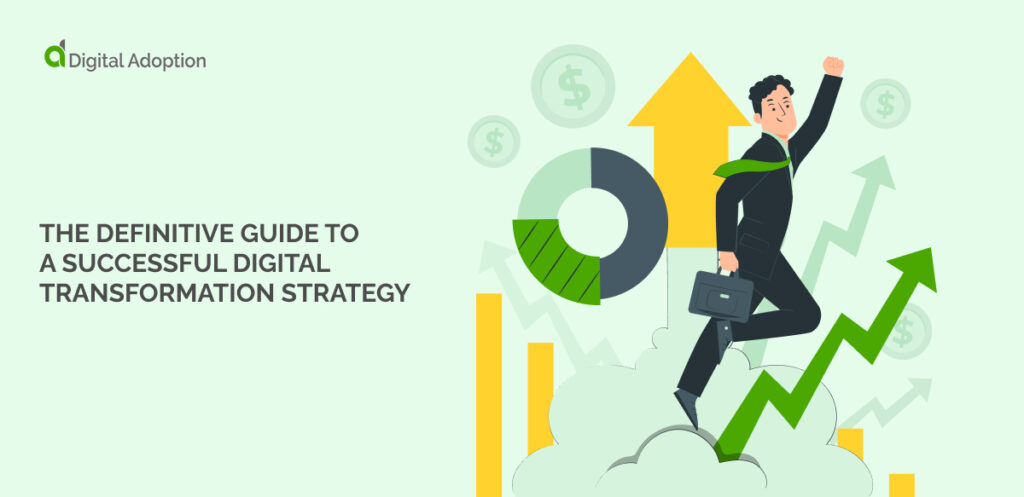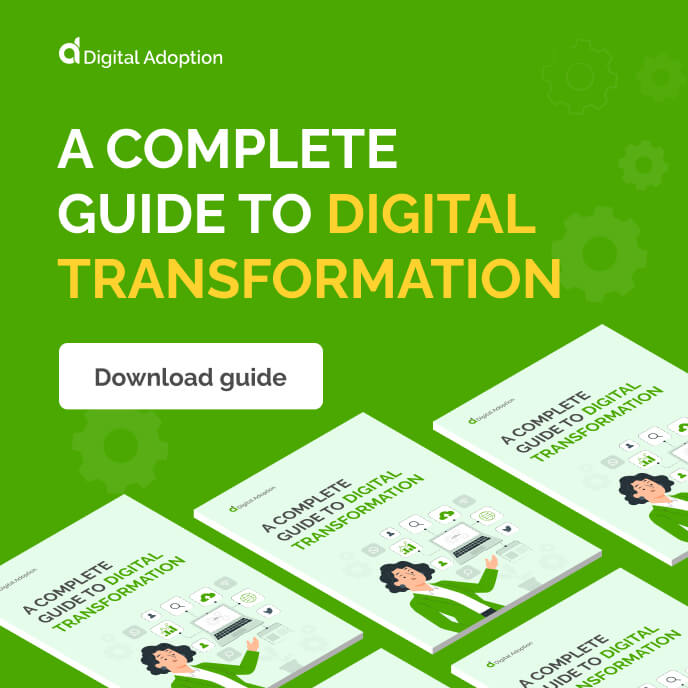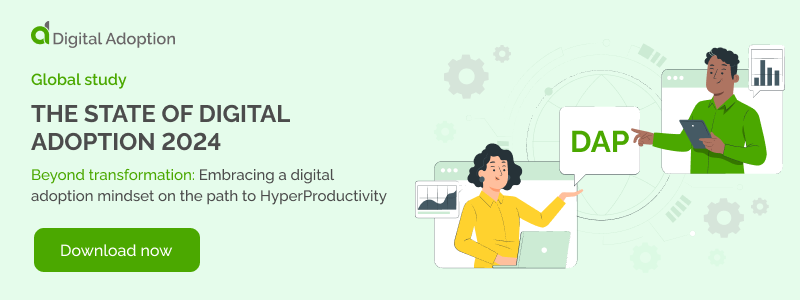A digital transformation strategy is a detailed plan outlining the steps you must take to digitize your business processes. A robust strategy helps you use digital tools to improve efficiency, collaboration, or virtually any other facet of your business.
The benefits of digital transformation are well documented. In a recent survey, Deloitte found that companies with higher digital maturity reported 45% revenue growth in FY19.
It’s widely accepted that modern businesses that want to remain competitive must invest in digital transformation.
But that itself can be an uphill battle. Only 34% of change initiatives succeed; without the right digital transformation strategy, you risk your digital adoption initiatives falling flat.
In this article, we’ve compiled everything we know about digital transformation strategy. By the time you’re done reading, you’ll know everything you need to know to make your digital transformation efforts successful.
We will take you all the way from the basics of understanding digital transformation strategy to practical advice on how to devise your own.
Understanding digital transformation strategy
The core elements of a digital transformation strategy
Your digital transformation strategy should contain four core elements: vision, process, technology, and people.
First, you must define a clear vision for your organization’s digital future. This involves setting out concrete goals and objectives and identifying how digital transformation will benefit your organization.
Second, you need to clearly define the processes that must be digitized. This involves assessing existing processes and identifying areas where digital tools can help streamline or optimize them.
Third, you must select the right technology to implement your digital transformation plan. This usually requires an in-depth assessment of the options available and selecting those that best meet your needs.
Finally, you must ensure your people are prepared for the digital transformation journey. Assessing their skill sets and providing necessary training or coaching is important.
The role of leadership in digital transformation
Leadership plays an important role in the success of any digital transformation strategy.
For a digital transformation strategy to succeed, strong leadership must drive it forward.
The leader is responsible for setting the vision and inspiring the rest of the team to believe in it.
They must also effectively communicate that vision and provide ongoing guidance and direction during implementation.
Leaders who are successful with digital transformation strategies typically possess certain qualities, such as:
- An openness to change
- Excellent communication skills
- A willingness to take risks
- Strong problem-solving abilities
In addition, they must understand digital technology and how it can be used to optimize business operations.
How leadership can foster a change-friendly culture
Leadership plays an important role in creating a culture of acceptance toward digital transformation initiatives within the organization.
Leaders should use their authority to model digital adoption, demonstrate its benefits, and encourage employees to embrace change.
They should also invest in training and development programs to ensure that all employees have the skills to successfully use digital tools.
By setting the right example, leaders can help create a culture open to digital transformation and foster a climate of innovation.
Employees tend to resist change, so one of the most powerful things you can do to further your competitive advantage is to foster a culture that supports it.
4 key considerations of a digital transformation strategy
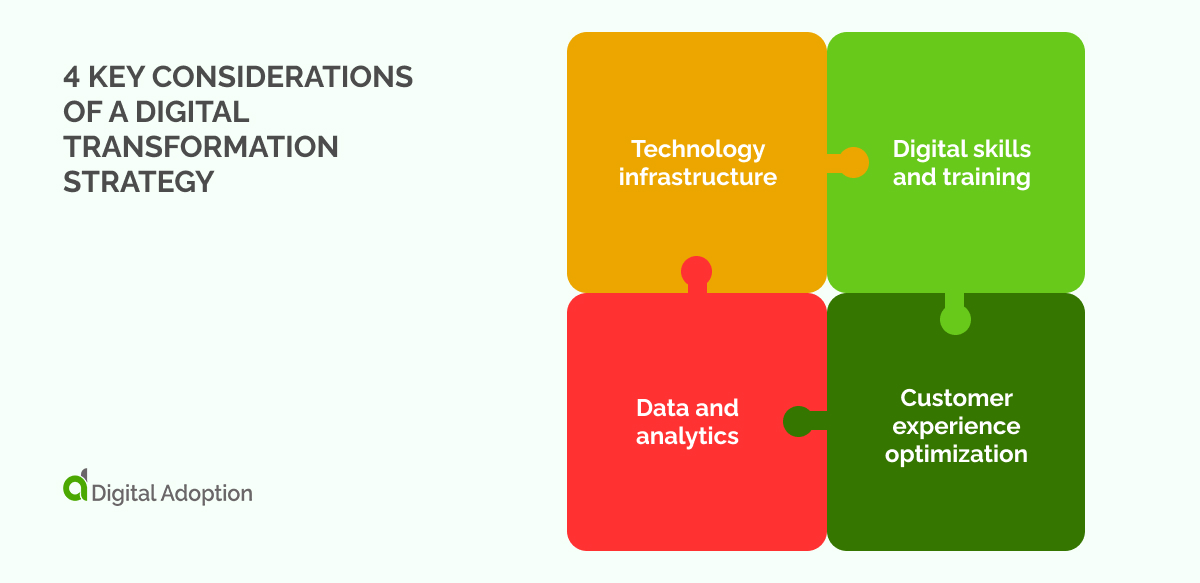
There’s more than one recipe for successful digital transformation. The best strategy for you will depend on several factors, and we can’t possibly account for them all.
However, any good digital transformation strategy will consider these four key components:
-
Technology infrastructure
Your technology infrastructure needs to be up-to-date and able to handle the demands of your digital transformation strategy.
It’s important to regularly assess and update existing systems to ensure they are fit for purpose and identify any new technologies that can help drive improvements in efficiency or customer experience.
-
Digital skills and training
The success of digital transformation relies on the involvement of all employees.
You must invest in training and upskilling to ensure everyone is prepared for the shift.
This should include technical skills like coding and soft skills like problem-solving and communication.
-
Customer experience optimization
In order to truly capitalize on digital transformation, you need to ensure that customers are at the heart of your strategy.
This means focusing on customer experience (CX) optimization.
This includes omnichannel customer service and personalization technology, which have been proven to improve CX.
-
Data and analytics
Data and analytics play a key role in digital transformation.
They are essential for measuring the success of your strategy, as well as helping to identify areas that need further improvement.
Analytics can help you gain deeper insights into your customers’ behavior, allowing you to develop more effective engagement strategies.
You can also use them to assess the performance of your existing digital initiatives and determine the areas that need more focus.
Creating a digital transformation roadmap in 6 steps
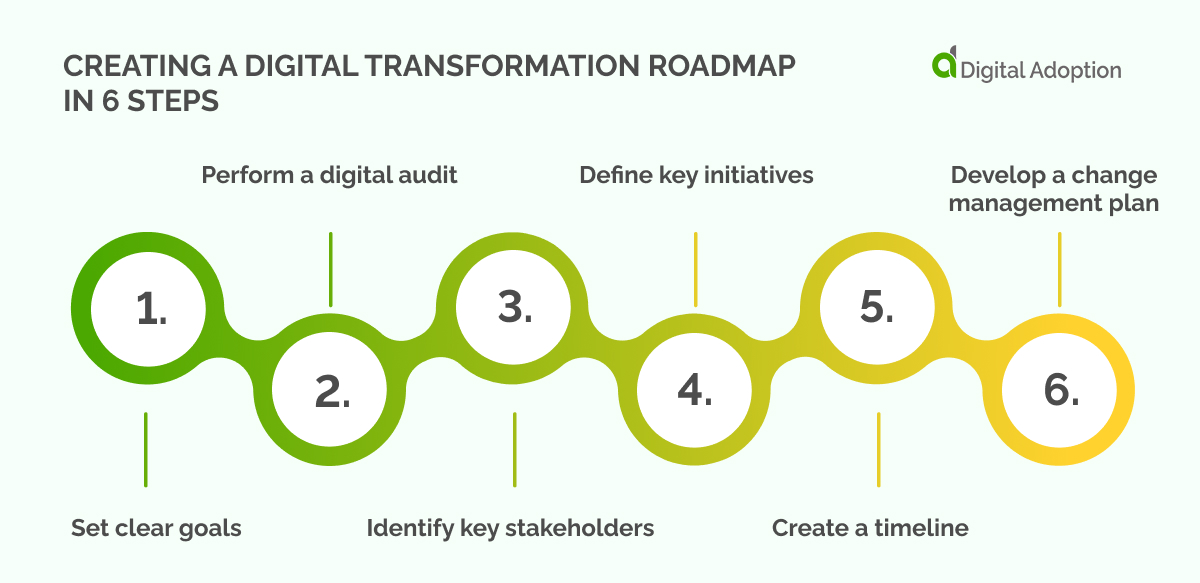
A well-defined roadmap can mean a smooth transition and a turbulent one.
Let’s delve into the intricacies of crafting an effective digital transformation roadmap.
Step 1: Set clear goals
Begin by defining what you hope to achieve with your digital transformation efforts.
Your objectives might involve improving customer experience, streamlining operations, boosting productivity, or combining these and other goals. Be as specific as possible.
Step 2: Perform a digital audit
Conduct a digital audit to understand your digital capabilities, infrastructure, and tools.
Identify gaps and areas where enhancement is needed to achieve your transformation goals.
Step 3: Identify key stakeholders
Your digital transformation will likely impact many departments.
Therefore, you should involve key stakeholders from these areas in the planning process to ensure their needs and concerns are addressed.
Step 4: Define key initiatives
Define key initiatives that will drive your transformation based on your goals and the outcome of your digital audit.
This might include adopting new technology, improving data analytics capabilities, or digitizing customer interactions.
Step 5: Create a timeline
Define the timeline for implementing these initiatives.
This will involve sequencing tasks, assigning responsibilities, and setting deadlines.
Step 6: Develop a change management plan
Digital transformation will involve processes, roles, and even company culture changes.
A change management plan will help manage these transitions smoothly and effectively.
Deloitte’s top tip for devising a digital transformation strategy
Deloitte has outlined a digital transformation strategy framework with one core tenet: Creating a strategic north star.
That north star should be a “pithy and compelling statement” that outlines:
Long-term vision
This is the final destination, which is important to have so that customers and stakeholders know where the digital transformation journey is headed.
Short- and medium-term vision
Having “mile markers” or short- and medium-term objectives is important along the route.
These should be clear, achievable, and measurable.
What it means for customers
Digital transformations are often built around customers’ needs and changing expectations.
Even if that is not the main focus, keeping an eye on customer needs is critical – which is why this should be defined clearly in the north star.
According to Deloitte, articulating your strategic north star is critical for any digital transformation strategy— but that’s only the first step in the digital transformation process.
Deloitte’s complete digital transformation framework consists of five stages:
- Strategy
- Business model
- Capabilities
- Operating model
- People, processes, and technology
These stages are also linked to three other key components of the digital transformation process:
- Agile mindset
- Digital adoption
- Customer success
Deloitte goes on to say that strategy drives digital transformation, not technology.
The firm claims that strategy should focus on specific aims, such as agility and digital maturity.
A strategy today paves the way for a digital future
As we continue to navigate through the digital era, it’s crucial for you to stay abreast of the latest trends to remain competitive.
Technology improves at an exponential rate, and digital adoption is only going to get harder with time.
That’s why we believe every business needs a strategy for handling digital transformation. The sooner you get a digital transformation strategy, the sooner you’ll be prepared for the ever-growing complexity of modern tech stacks.
If you want to foster a culture of continuous learning, build business adaptability, and future-proof your organization, you need a robust digital transformation strategy to ease the process of digitization so you can focus on what matters.
The only constant in the digital world is change.
Businesses that are open to change and willing to adapt will be the ones that stay ahead in the digital transformation journey.

